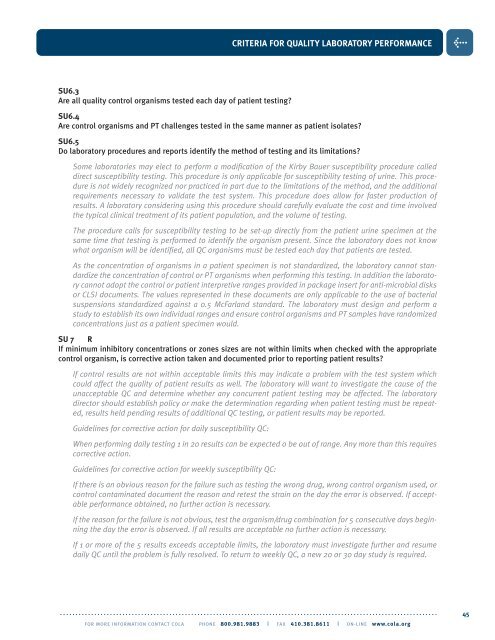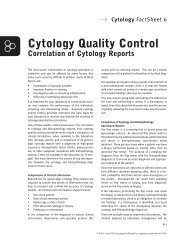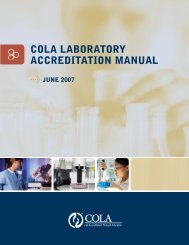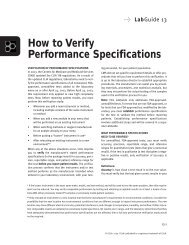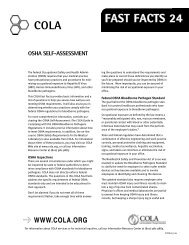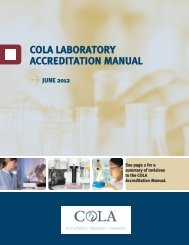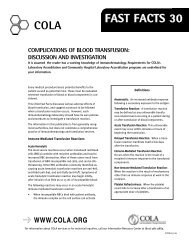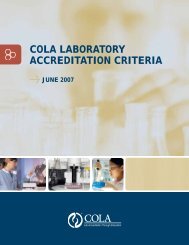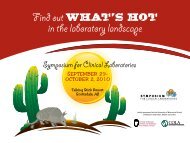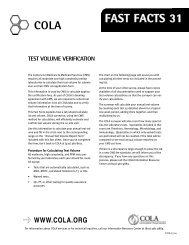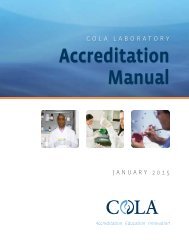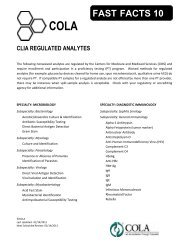#06-5558 Accrd Manual V7 - COLA
#06-5558 Accrd Manual V7 - COLA
#06-5558 Accrd Manual V7 - COLA
- No tags were found...
You also want an ePaper? Increase the reach of your titles
YUMPU automatically turns print PDFs into web optimized ePapers that Google loves.
CRITERIA FOR QUALITY LABORATORY PERFORMANCE>SU6.3Are all quality control organisms tested each day of patient testing?SU6.4Are control organisms and PT challenges tested in the same manner as patient isolates?SU6.5Do laboratory procedures and reports identify the method of testing and its limitations?Some laboratories may elect to perform a modification of the Kirby Bauer susceptibility procedure calleddirect susceptibility testing. This procedure is only applicable for susceptibility testing of urine. This procedureis not widely recognized nor practiced in part due to the limitations of the method, and the additionalrequirements necessary to validate the test system. This procedure does allow for faster production ofresults. A laboratory considering using this procedure should carefully evaluate the cost and time involvedthe typical clinical treatment of its patient population, and the volume of testing.The procedure calls for susceptibility testing to be set-up directly from the patient urine specimen at thesame time that testing is performed to identify the organism present. Since the laboratory does not knowwhat organism will be identified, all QC organisms must be tested each day that patients are tested.As the concentration of organisms in a patient specimen is not standardized, the laboratory cannot standardizethe concentration of control or PT organisms when performing this testing. In addition the laboratorycannot adopt the control or patient interpretive ranges provided in package insert for anti-microbial disksor CLSI documents. The values represented in these documents are only applicable to the use of bacterialsuspensions standardized against a 0.5 McFarland standard. The laboratory must design and perform astudy to establish its own individual ranges and ensure control organisms and PT samples have randomizedconcentrations just as a patient specimen would.SU 7 RIf minimum inhibitory concentrations or zones sizes are not within limits when checked with the appropriatecontrol organism, is corrective action taken and documented prior to reporting patient results?If control results are not within acceptable limits this may indicate a problem with the test system whichcould affect the quality of patient results as well. The laboratory will want to investigate the cause of theunacceptable QC and determine whether any concurrent patient testing may be affected. The laboratorydirector should establish policy or make the determination regarding when patient testing must be repeated,results held pending results of additional QC testing, or patient results may be reported.Guidelines for corrective action for daily susceptibility QC:When performing daily testing 1 in 20 results can be expected o be out of range. Any more than this requirescorrective action.Guidelines for corrective action for weekly susceptibility QC:If there is an obvious reason for the failure such as testing the wrong drug, wrong control organism used, orcontrol contaminated document the reason and retest the strain on the day the error is observed. If acceptableperformance obtained, no further action is necessary.If the reason for the failure is not obvious, test the organism/drug combination for 5 consecutive days beginningthe day the error is observed. If all results are acceptable no further action is necessary.If 1 or more of the 5 results exceeds acceptable limits, the laboratory must investigate further and resumedaily QC until the problem is fully resolved. To return to weekly QC, a new 20 or 30 day study is required.. . . . . . . . . . . . . . . . . . . . . . . . . . . . . . . . . . . . . . . . . . . . . . . . . . . . . . . . . . . . . . . . . . . . . . . . . . . . . . . . . . . . . . . . . . . . . . . . . . . . . . . . . . . . . . . . . . . . . . . . .FOR MORE INFORMATION CONTACT <strong>COLA</strong> PHONE 800.981.9883 | FAX 410.381.8611 | ON-LINE www.cola.org45


